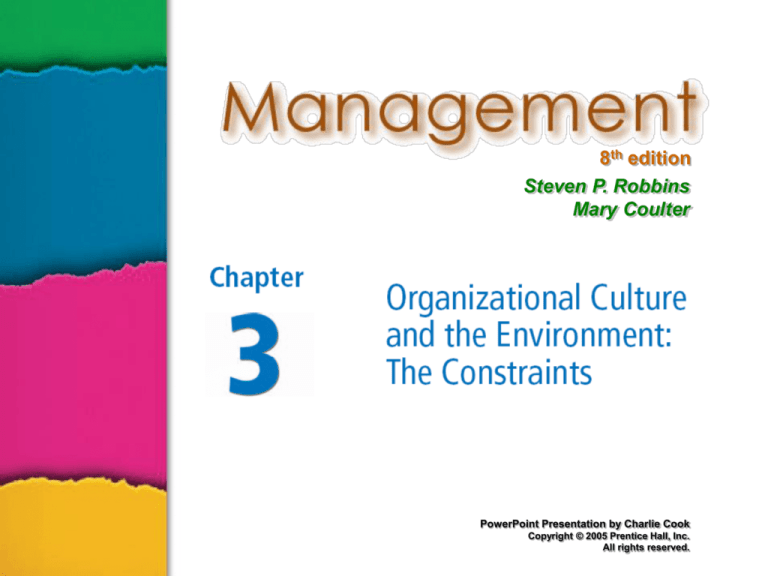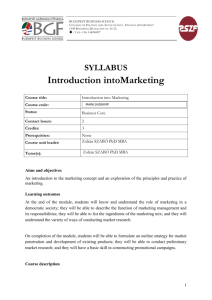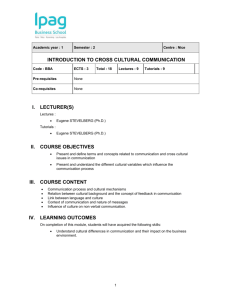
8th edition
Steven P. Robbins
Mary Coulter
PowerPoint Presentation by Charlie Cook
Copyright © 2005 Prentice Hall, Inc.
All rights reserved.
LEARNING OUTLINE
Follow this Learning Outline as you read and study this chapter.
The Manager: Omnipotent or Symbolic
• Define the omnipotent and symbolic views of
management.
• Contrast the action of manager according to the
omnipotent and symbolic views.
• Explain the parameters of managerial discretion.
The Organization’s Culture
• Define organizational culture.
• Explain what the definition of culture implies.
• Describe the seven dimensions of organizational culture.
• Define a strong culture.
Copyright © 2005 Prentice Hall, Inc. All rights reserved.
3–2
LEARNING OUTLINE
Follow this Learning Outline as you read and study this chapter.
The Organization’s Culture (cont’d)
• List the factors that influence the strength of an
organization’s culture.
• Discuss the impact of a strong culture on organizations
and managers.
• Explain the source of an organization’s culture.
• Describe how an organization’s culture continues.
• Explain how culture is transmitted to employees.
• Describe how culture affects managers.
• Describe how managers can create a culture that
supports diversity.
Copyright © 2005 Prentice Hall, Inc. All rights reserved.
3–3
L E A R N I N G O U T L I N E (cont’d)
Follow this Learning Outline as you read and study this chapter.
Current Organizational Issues Facing Managers
• Explain how a strong culture affects whether an
organization is ethical.
• Describe the characteristics of an ethical culture.
• List some suggestions for creating a more ethical culture.
• Describe the characteristics of an innovative culture.
• Explain six characteristics of a customer-responsive
culture.
• Discuss the actions managers can take to make their
cultures more customer-responsive.
• Define workplace spirituality.
Copyright © 2005 Prentice Hall, Inc. All rights reserved.
3–4
L E A R N I N G O U T L I N E (cont’d)
Follow this Learning Outline as you read and study this chapter.
Current Organizational Issues Facing Managers
(cont’d)
• Define workplace spirituality.
• Explain why workplace spirituality seems to be an
important concern.
• Describe the characteristics of a spiritual organization.
• Discuss the criticisms of spirituality.
•The Environment
• Define the external environment an specific and general
environment.
• Describe the components of the specific environment.
Copyright © 2005 Prentice Hall, Inc. All rights reserved.
3–5
L E A R N I N G O U T L I N E (cont’d)
Follow this Learning Outline as you read and study this chapter.
•The Environment (cont’d)
• Describe the components of the general environment.
• Define and discuss environmental uncertainty and its two
dimensions.
• Define stake holders.
• Identify the most common organizational stakeholders.
• Explain why stakeholder relationship management is
important.
Copyright © 2005 Prentice Hall, Inc. All rights reserved.
3–6
The Manager: Omnipotent or Symbolic?
• Omnipotent View of Management
Managers are directly responsible for an
organization’s success or failure.
The quality of the organization is determined by the
quality of its managers.
Managers are held most accountable
for an organization’s performance
yet it is difficult to attribute
good or poor performance
directly to their influence
on the organization.
Copyright © 2005 Prentice Hall, Inc. All rights reserved.
3–7
The Manager: Omnipotent or Symbolic?
• Symbolic View of Management
Much of an organization’s success or failure is due to
external forces outside of managers’ control.
The ability of managers to affect outcomes is
influenced and constrained by external factors.
The
economy, customers, governmental policies,
competitors, industry conditions,
technology, and the actions of
previous managers
Managers symbolize control and
influence through their action
Copyright © 2005 Prentice Hall, Inc. All rights reserved.
3–8
The Organization’s Culture
• Organizational Culture
A system of shared meanings and common beliefs
held by organizational members that determines, in a
large degree, how they act towards each other.
“The way we do things around here.”
Values,
symbols, rituals, myths, and practices
Implications:
Culture
is a perception.
Culture is shared.
Culture is descriptive.
Copyright © 2005 Prentice Hall, Inc. All rights reserved.
3–9
Strong versus Weak Cultures
• Strong Cultures
Are cultures in which key values are deeply held and
widely held.
Have a strong influence on organizational members.
• Factors Influencing the Strength of Culture
Size of the organization
Age of the organization
Rate of employee turnover
Strength of the original culture
Clarity of cultural values and beliefs
Copyright © 2005 Prentice Hall, Inc. All rights reserved.
3–10
Benefits of a Strong Culture
• Creates a stronger employee commitment to the
organization.
• Aids in the recruitment and socialization of new
employees.
• Fosters higher organizational
performance by instilling and
promoting employee initiative.
Copyright © 2005 Prentice Hall, Inc. All rights reserved.
3–11
Organizational Culture
• Sources of Organizational Culture
The organization’s founder
Vision
and mission
Past practices of the organization
The
way things have been done
The behavior of top management
• Continuation of the Organizational Culture
Recruitment of like-minded employees who “fit.”
Socialization of new employees to help them adapt to
the culture
Copyright © 2005 Prentice Hall, Inc. All rights reserved.
3–12
How Employees Learn Culture
• Stories
Narratives of significant events or actions of people that convey
the spirit of the organization
• Rituals
Repetitive sequences of activities that express and reinforce the
values of the organization
• Material Symbols
Physical assets distinguishing the organization
• Language
Acronyms and jargon of terms, phrases, and word meanings
specific to an organization
Copyright © 2005 Prentice Hall, Inc. All rights reserved.
3–13
How Culture Affects Managers
• Cultural Constraints on Managers
Whatever managerial actions the organization
recognizes as proper or improper on its behalf
Whatever organizational activities the organization
values and encourages
The overall strength or weakness of the
organizational culture
Simple rule for getting ahead in an organization:
Find out what the organization rewards and do those things.
Copyright © 2005 Prentice Hall, Inc. All rights reserved.
3–14
Organization Culture Issues
• Creating an Ethical
Culture
High in risk tolerance
Low to moderate
aggressiveness
Focus on means as
well as outcomes
Copyright © 2005 Prentice Hall, Inc. All rights reserved.
• Creating an Innovative
Culture
Challenge and
involvement
Freedom
Trust and openness
Idea time
Playfulness/humor
Conflict resolution
Debates
Risk-taking
3–15
Organization Culture Issues (cont’d)
• Creating a Customer-Responsive Culture
Hiring the right type of employees (ones with a strong
interest in serving customers)
Having few rigid rules, procedures, and regulations
Using widespread empowerment of employees
Having good listening skills in relating to customers’
messages
Providing role clarity to employees to reduce
ambiguity and conflict and increase job satisfaction
Having conscientious, caring employees willing to
take initiative
Copyright © 2005 Prentice Hall, Inc. All rights reserved.
3–16
Spirituality and Organizational Culture
•Workplace Spirituality
The recognition that people have an inner life that
nourishes and is nourished by meaningful work that
takes place in the context of community.
•Characteristics of a Spiritual Organization
Strong sense of purpose
Focus on individual development
Trust and openness
Employee empowerment
Toleration of employees’ expression
Copyright © 2005 Prentice Hall, Inc. All rights reserved.
3–17
Benefits of Spirituality
• Improved employee productivity
• Reduction of employee turnover
• Stronger organizational performance
• Increased creativity
• Increased employee satisfaction
• Increased team performance
• Increased organizational performance
Copyright © 2005 Prentice Hall, Inc. All rights reserved.
3–18
Defining the External Environment
• External Environment
The forces and institutions outside the organization
that potentially can affect the organization’s
performance.
• Components of the External Environment
Specific environment: external forces that have a
direct and immediate impact on the organization.
General environment: broad economic, sociocultural, political/legal, demographic, technological,
and global conditions that may affect the organization.
Copyright © 2005 Prentice Hall, Inc. All rights reserved.
3–19
How the Environment Affects Managers
• Environmental Uncertainty
The extent to which managers have knowledge of
and are able to predict change their organization’s
external environment is affected by:
Complexity
of the environment: the number of
components in an organization’s external environment.
Degree of change in environmental components: how
dynamic or stable the external environment is.
Copyright © 2005 Prentice Hall, Inc. All rights reserved.
3–20
Stakeholder Relationships
• Stakeholders
Any constituencies in the organization’s external
environment that are affected by the organization’s
decisions and actions
• Why Manage Stakeholder Relationships?
It can lead to improved organizational performance.
It’s the “right” thing to do given the interdependence
of the organization and its external stakeholders.
Copyright © 2005 Prentice Hall, Inc. All rights reserved.
3–21
Managing Stakeholder Relationships
1. Identify the organization’s external
stakeholders.
2. Determine the particular interests and
concerns of the external stakeholders.
3. Decide how critical each external stakeholder
is to the organization.
4. Determine how to manage each individual
external stakeholder relationship.
Copyright © 2005 Prentice Hall, Inc. All rights reserved.
3–22









